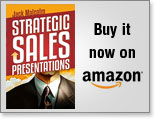If you read and apply the lessons from the books I’ve recommended so far for your professional sales education, you will eventually get rewarded (or punished, depending on how you look at it) by being promoted to sales management.
You will quickly find out that what got you there won’t keep you there, and one of the most important lessons is that you can’t do everything yourself, as I illustrate with my story about a WWII tank commander and a young private.
To help you navigate the transition from selling to supporting, enabling and coaching your sales team’s performance, you can ask for no better mentors that Dave Brock and Mike Weinberg.
I’ve previously written reviews of their two books, and you will find more detailed descriptions here:
Sales Manager Survival Guide, by Dave Brock
Sales Management. Simplified., by Mike Weinberg
Imagine your boss sends you to the store to buy a frimfram. You’ve never heard of frimframs, you have no idea what a frimfram does, yet you have to buy one. You go to the aisle where the frimframs are and see a couple of choices with different prices. Two questions immediately come to mind: what’s the difference between the two, and what are those differences worth? If you can’t answer the first question, you would be silly to buy the more expensive one.
Differentiation is the core of selling. We all want to solve problems, sell solutions, become trusted advisors or consultants, and it all starts with differentiation.
The only reason you have a job as a salesperson is to help your customers make decisions, and every buying decision is fundamentally about differentiators: what are they, what does that mean, and what’s the difference worth? It doesn’t matter how great your product is, how much it does for those who buy it—if it’s not different in some way there is only one way to sell it, which is to drop your price.
One key theme of Sales Differentiation is that it is YOUR job to differentiate what you sell and connect it to value for the buyer. It’s not marketing’s job; their job is to get the customer interested, but it’s your job to get them to take action. and it’s certainly not the customer’s job.
What’s different about this book?
Because I’m “selling” this book to you, it’s only fair that I tell you what’s different, and I’ll use Salz’s distinction between WHAT you sell and HOW you sell.
This book will help you change WHAT you sell by helping you go “outside the box” to find differences beyond the product itself. If you use the checklist in Chapter 5 it’s easily worth the price of the book—but then skip to Chapter 19 to remind yourself of the single most important differentiator.
This book will help you change HOW you sell by helping you choose different words, develop a “sales crime theory”, and ask the right questions, to name just three differences.
Finally, Salz’s ideas are sensible and actionable. He brings a ton of practical experience selling and running sales teams and illustrates his ideas with instructive examples, both in his experience as a seller and as a buyer.
What are those differences worth to you?
You won’t waste customers’ time talking about things they don’t care about.
You will be better positioned to realize the price you want.
You will gain the confidence to go beyond asking customers what they want, to shaping their perception of their needs and requirements.
There’s only one question the book does not answer: what’s the difference between a difference and a differentiator? My take is this: all offerings have differences, but it takes a differentiator to make those meaningful to the buyer. Buy this book, and you will be that person.
The complexity of B2B sales requires that you have an effective strategy and overarching approach for consistent success. Continuing my series on professional sales education, here are four books I recommend that every B2B sales professional should read.
I’ve previously posted detailed reviews, which you can access here:
Consultative Selling, by Mack Hanan
This is the granddaddy of all sales process books, first published in 1970 and still relevant today.
The Challenger Sale, by Matthew Dixon and Brent Adamson
How to teach, tailor, and take control of the sales process.
Beyond the Sales Process, by Dave Stein and Steve Andersen
There is a lot of work you should be doing before and after the actual sales process.
Bottom-Line Selling, by Jack Malcolm
Regardless of methodology, you still need to connect your solution to measurable business improvements.
If you work for a company that provides effective sales training, congratulations. That’s a great start.
But, although this may sound strange coming from someone who delivers sales training for a living, if you’re relying only on others for your sales education, you will never be exceptional.
You need to take charge of your own sales education. You need to read, and really study and apply the lessons contained in some of the great sales books out there. There are so many to choose from, and even I have only read a fraction of them, so I’m going to write a series of posts recommending my favorites.
In the video attached to this post, I introduce four books about face to face selling skills that every sales professional should read. I’ve previously written about each book in detail, and you can see the links to those posts below:
The Only Sales Guide You’ll Ever Need, by Anthony Iannarino
New Sales. Simplified., by Mike Weinberg



